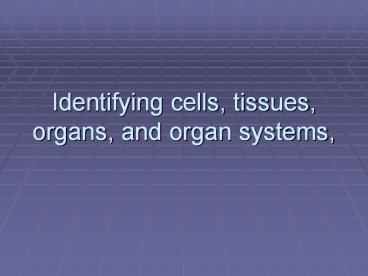Identifying cells, tissues, organs, and organ systems, - PowerPoint PPT Presentation
1 / 16
Title:
Identifying cells, tissues, organs, and organ systems,
Description:
Identifying cells, tissues, organs, and organ systems, Cells A structural unit of all living things. The smallest unit classified as an living organism. – PowerPoint PPT presentation
Number of Views:273
Avg rating:3.0/5.0
Title: Identifying cells, tissues, organs, and organ systems,
1
Identifying cells, tissues, organs, and organ
systems,
2
Cells
- A structural unit of all living things. The
smallest unit classified as an living organism.
3
Tissues
- Tissues are an ensemble of cells, they are not
the same but the are of the same origin, that
carries out an function. - A bunch of cells that work together
4
Organs
- Organs are groups of tissue that perform
different functions. There are many organs in the
body like skin, kidney, liver, and etc.
5
Organ Systems
- Some types of organ systems are, Circulatory,
Respiratory, Digestive, Nervous, and Reproductive.
6
Digestive System
- breaks down proteins, fats and all carbohydrates
into smaller molecules, which can then be
absorbed along with vitamins and minerals
7
(No Transcript)
8
Respiratory
- Absorbs oxygen from the air and excretes the
waste product carbon dioxide to the air.
9
(No Transcript)
10
Circulatory system
- distributes nutrients and oxygen to all body
cells plus hormones to target cells, carries
waste products to the organs of excretion
(kidneys, lungs), toxins to the liver for
detoxification and also helps fight infections
through its white blood cells
11
(No Transcript)
12
Skeletal system
- It supports the body and protects it. It is also
what all the are muscles attached to, without
that you couldn't use them.
13
Muscular system
- The main purpose of the muscular system is to
provide movement for the body. The muscular
system consists of mucles
14
Urinary System
- Remove wastes from the body.
- Regulate levels of electrolytes in the body.
- Regulate hydration of the body.
- Maintain acid-base balance of the body.
- Maintain blood pressure.
15
Nervous System
- To provide communication in the body, sensations,
thoughts, emotions, memories and controls your
reactions.
16
How do the organ systems work together?
- distributes the above nutrients and oxygen to all
body cells plus hormones to target cells, carries
waste products to the organs of excretion
(kidneys, lungs), toxins to the liver for
detoxification and also helps fight infections
through its white blood cells































